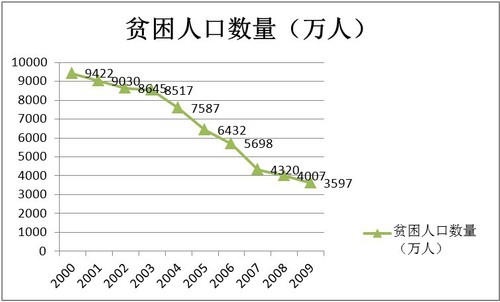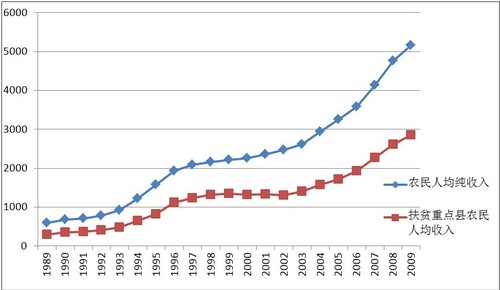(II)Effectiveness of Poverty Alleviation and Development
Due to historical and institutional reasons, China's rural poverty is quite conspicuous. Since reform and opening up in 1978, relying on pro-poor economic growth and the large-scale poverty alleviation and development programs of the Chinese government launched in 1986, especially since 2002, many major policy initiatives such as promoting poverty alleviation through urban-rural coordination have greatly alleviated the rural poverty and basically solved the food and clothing problem of a large number of poor people, and China has made remarkable achievements in poverty reduction.
(I)Substantial reduction in the number of poverty-stricken people
According to the poverty line of the National Bureau of Statistics, the number of rural people living below the poverty line dropped from 250 million in 1978 to 35.97 million at the end of 2009 and the incidence of poverty declined from 30.7% to 3.8%. Based on the poverty line of the Chinese government, the number of rural poor without access to adequate food and clothing declined from 250 million in 1978 to 14.79 million in 2007, and incidence of poverty in rural areas declined from 30.7% to 1.6%; the number of the low-income people whose food and clothing problem has been solved basically but not steadily dropped from 62.13 million in 2000 to 28.41 million in 2008, and the incidence of poverty in rural areas declined from 6.7% to 3%. In 2008, the rural poverty line was adjusted to 1196 Yuan, and from 2008 onwards, the poor and low-income population statistics were combined. Under this statistical standard, by the end of 2009, the number of poor people was reduced to 35.971 million, accounting for 3.8% of the total rural residents.
Source: National Bureau of Statistics, "Poverty Monitoring Report of Rural China" and relevant statistics of LGOP
(II)Steady increase of farmers' income in poor areas From 1989 to 2009, in the key counties for national poverty alleviation and development (hereinafter referred to as key counties), the rural per capita net income rose from 303 Yuan to 2842 Yuan. Especially from 2001 to 2009, the rural per capita net income of key counties increased from 1277 Yuan to 2842 Yuan, with an average annual growth above the national average of 7.47% for five consecutive years.
Source: National Bureau of Statistics, "Poverty Monitoring Report of Rural China" and relevant data of LGOP
(III)Significant improvement of infrastructure By the end of 2009, the proportion of the natural villages with access to roads, electricity, telephone lines and radio and TV programs in the key counties respectively reached 99%, 98.7%, 98% and 98%. From 2000 to 2008, the key counties had additional basic farmland of 5940 mu; newly built or rebuilt highroads of 780,000 kilometers; set up buildings of 21.52 million square meters for education and health care and solved the drinking water problem for 49.59 million people and 43.97 million livestock, and 60.3% of the rural households began to drink tap water and deep well water.
(IV)Profound changes in social undertakings From 2002 to 2009, in the key counties, the proportion of the administrative villages with kindergartens and preschools rose from 51.3% to 55.8%; the proportion of the administrative villages with clinics rose from 68.6% to 79.6%; the proportion of the administrative villages with qualified rural doctors and health workers increased from 70.8% to 79% and the proportion of the administrative villages with qualified midwives rose from 66.6% to 75%. Meanwhile, the illiteracy and semi-literacy rate among the rural labor force in the key counties dropped from 15.3% in 2002 to 10.8% in 2009 and the proportion of the trained labors rose from 8.6% to 15.5%.
(V)Rapid development of regional economy From 2000 to 2008, in the 592 key counties, the GDP per capita rose from 2,500 Yuan to 8,368 Yuan, with an average annual increase of 22.2%, and the per capita income of general budget increased from 116.5 Yuan to 354.3 Yuan, with an average annual growth of 24.5%. The growth rates of these two indicators are both slightly higher than the average level of 2072 counties. Some of the key counties have achieved extraordinary development through the development of energy and tourism industry or the adjustment of industrial structure. The pace of construction of rural market in impoverished areas has been accelerated and a market circulation system has been basically established, which alleviated the difficulties of the poor in sales and improved the consumption level of rural markets. By the end of 2008, the per capita GDP of 37 key counties and the per capita revenue of 61 key counties were above the national average, and the per capita GDP and per capita revenue of 30 key counties were both above the national average.
The great achievements in poverty alleviation and development have not only promoted the economic and social development in poor areas, alleviated rural poverty and optimized the national economic structure, but also played an important role in promoting national unity, political stability, border consolidation and social harmony.
China’s achievements in poverty alleviation and development have also accelerated the process of global poverty reduction and made a contribution to the cause of global poverty reduction. Particularly its progress in achieving the Millennium Development Goals is prominent. According to the World Bank statistics, China’s achievements in poverty alleviation over the past 25 years account for 67% of the total in the world. Without China's contribution, it will be impossible to achieve the first target of the MDGs –halving the number of people living in extreme poverty by 2015.
According to the Chinese government's poverty line, the number of the people living in absolute poverty without access to adequate food and clothing dropped from 85 million in 1990 (accounting for 9.6% of rural population) to 10.03 million in 2008 (accounting for 1% of rural population), and China is the first developing country to achieve the poverty reduction target of the MDGs ahead of schedule. Based on the international poverty line of one dollar per person per day adopted by the MDGs, the proportion of rural residents of China living below the poverty line also dropped from 46% in 1990 to 10.4% in 2005, and China has also achieved the poverty reduction target of the MDGs. From 1990 to 2005, the number of the poor living below the poverty line of one dollar per person per day was reduced to 1.4 billion in the world, with a decrease of 418 million, 23% down, and Chin’s poverty reduction accounted for more than 70% of the total in the world (2006). (Ministry of Foreign Affairs and the UN System in China, "Report on China's Progress towards the Millennium Development Goals")

扫描下载手机客户端
地址:北京朝阳区太阳宫北街1号 邮编100028 电话:+86-10-84419655 传真:+86-10-84419658(电子地图)
版权所有©中国国际扶贫中心 未经许可不得复制 京ICP备2020039194号-2


